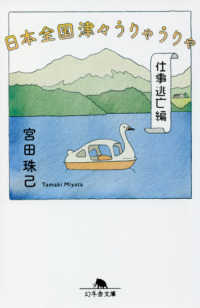- ホーム
- > 洋書
- > 英文書
- > History / World
Full Description
Human skeletons are widely studied in archaeological, anthropological and forensic settings to learn about the deceased. Methods used to identify individuals in forensic contexts and to determine age and sex in archaeological settings are normally tested on identified skeletal collections: collections of skeletons with known age-at-death, sex, often occupation and cause of death. These collections often represent individuals dying within the last century, but this is variable and often depends on the purpose for creating the collection. Many were developed in attempts to understand local population biology whereas those collected recently are for forensic purposes: to improve identification in legal contexts. Some of these collections were developed from body donation programmes, while others have come from cemeteries: cemeteries which were either no longer viable or needed clearing. All these factors impact on who curates these collections: archaeology or anthropology departments and museums. However, unlike many other skeletons curated in these locations, these are individuals with names. All this raises ethical questions about their creation, curation and their use for research. This book focusses on identified skeletal collections in the UK, Portugal, South Africa, USA and Canada. The chapters discuss how and why collections were amassed including the local legislation governing them. Alongside this run the ethical issues associated with their collection, curation and access to them. The demographics of the collections: who is included and why, along with such biases and how they can impact on research are also discussed, as are limitations in the documentary data associated with these individuals. The importance of these collections is also focussed on: particularly their role in developing and testing methods for age determination in adults. This shows why these collections are so vital to improve methods and interpretations for archaeological and forensic research. The importance of communicating this to the wider public is also addressed.
Contents
Chapter 1. Introduction - Charlotte Henderson; Chapter 2. Archaeological human skeletal collections: their significance and value as an ongoing contribution to research - Jelena Bekvalac and Dr Rebecca Redfern; Chapter 3. The Grant Human Skeletal Collection and Other Contributions of J. C. B. Grant to Anatomy, Osteology, and Forensic Anthropology - John Albanese; Chapter 4. Strategies for Dealing with Bias in Identified Reference Collections and Implications for Research in the 21st Century - John Albanese; Chapter 5. Bioarchaeology and Identified Skeletal Collections: Problems and Potential Solutions - Jennifer Sharman and John Albanese; Chapter 6. The significance of identified human skeletal collections to further our understanding of the skeletal ageing process in adults - Vanessa Campanacho and Hugo F.V. Cardoso; Chapter 7. Secular changes in cranial size and sexual dimorphism of cranial size: a comparative analysis of standard cranial dimensions in two Portuguese identified skeletal reference collections and implications for sex estimation - Luísa Marinho, Ana R. Vassalo and Hugo F. V. Cardoso; Chapter 8. Lives Not Written in Bones: Discussing Biographical Data Associated With Identified Skeletal Collections - Francisca Alves Cardoso; Chapter 9. The Fate of Anatomical Collections in the US: Bioanthropological Investigations of Structural Violence - Rachel J. Watkins; Chapter 10. Final Summary - Francisca Alves-Cardoso






